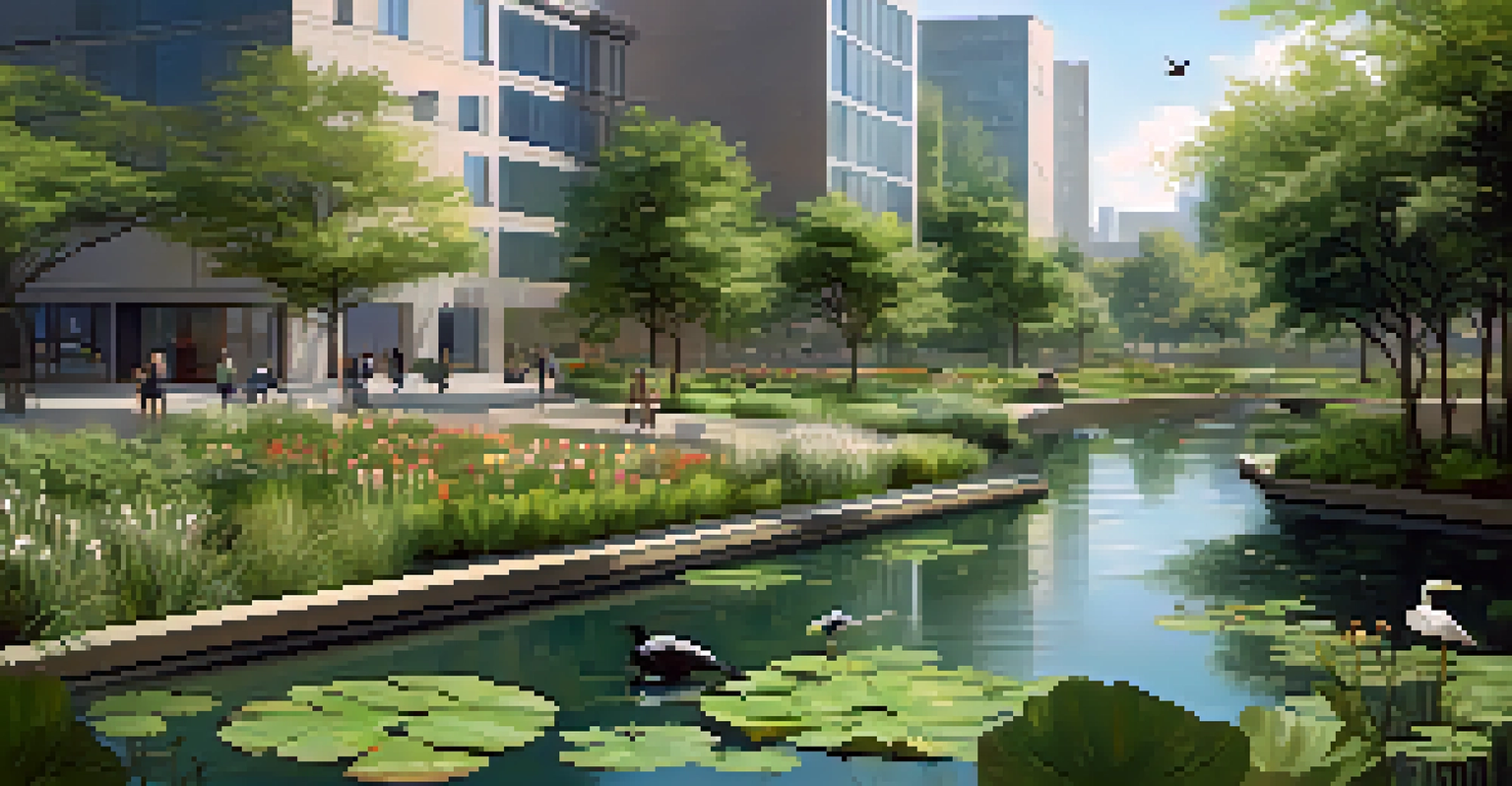The Role of Botanical Gardens in Promoting Urban Biodiversity

Understanding Urban Biodiversity and Its Importance
Urban biodiversity refers to the variety of life found in city environments, including plants, animals, and microorganisms. This diversity is crucial for maintaining healthy ecosystems, contributing to air quality, and providing green spaces for city dwellers. As cities continue to expand, preserving and promoting urban biodiversity becomes a pressing concern.
In every walk with nature one receives far more than he seeks.
Botanical gardens play a key role in this context by serving as sanctuaries for various species, often housing plants that are rare or endangered. They not only protect these species but also educate the public about their importance and the need for conservation. By showcasing a range of biodiversity, these gardens inspire visitors to appreciate and advocate for nature in urban settings.
Additionally, urban biodiversity supports local climate regulation and can reduce the heat island effect commonly found in cities. Through their diverse plant collections, botanical gardens help to mitigate the impacts of urbanization, making cities more livable and resilient.
Botanical Gardens as Educational Hubs for Biodiversity
One of the most significant roles of botanical gardens is their function as educational centers. They offer workshops, guided tours, and interactive exhibits that teach visitors about local flora and fauna. By engaging with the community, botanical gardens foster a deeper understanding of biodiversity and its benefits to urban environments.

These educational initiatives often target schools and youth programs, encouraging the next generation to develop a passion for nature conservation. Field trips to botanical gardens can spark curiosity and inspire students to learn about ecology and environmental science. This hands-on experience is invaluable in cultivating future advocates for urban biodiversity.
Urban Biodiversity Enhances Ecosystems
Urban biodiversity is essential for creating healthy ecosystems, improving air quality, and providing green spaces in cities.
Moreover, many botanical gardens collaborate with local universities and research institutions to conduct studies on plant species and ecosystems. These partnerships not only enhance the scientific knowledge base but also provide real-world applications for students and researchers alike, further solidifying the garden's role as a center of learning.
Conservation Efforts and Biodiversity Preservation
Botanical gardens are often at the forefront of conservation efforts, actively participating in the preservation of endangered species. They maintain living collections that serve as genetic reservoirs, ensuring that rare plants can be propagated and, if necessary, reintroduced into their natural habitats. This is crucial for maintaining genetic diversity, which is vital for species resilience.
The environment is where we all meet; where we all have a mutual interest; it is the one thing all of us share.
In addition to plant conservation, many botanical gardens engage in habitat restoration projects. By restoring local ecosystems, they create safe havens for various wildlife species, thus enhancing urban biodiversity. These projects often involve community volunteers, fostering a sense of shared responsibility and connection to nature among local residents.
Furthermore, botanical gardens advocate for sustainable practices and policies that protect biodiversity at the city level. They work with local governments to promote green infrastructure, such as green roofs and rain gardens, which support wildlife and improve urban ecosystems.
Creating Green Spaces for Urban Wildlife
Botanical gardens are vital in creating green spaces that support urban wildlife. These gardens provide essential habitats for pollinators, birds, and other small animals, offering food sources and shelter in densely populated areas. The diverse plantings attract a variety of species, contributing to a more balanced urban ecosystem.
Moreover, botanical gardens often implement design strategies that enhance wildlife-friendly environments. For example, planting native species can attract local pollinators, while providing water features can support amphibians and other aquatic life. These thoughtful designs help urban areas become more inviting to wildlife.
Botanical Gardens as Community Hubs
Botanical gardens serve as educational centers, engaging the community in conservation efforts and fostering a deeper understanding of local biodiversity.
By showcasing these green spaces, botanical gardens demonstrate the importance of incorporating nature into urban planning. They inspire city planners and developers to consider wildlife needs in their designs, promoting a more harmonious coexistence between urban development and nature.
Engaging the Community through Volunteer Programs
Volunteer programs at botanical gardens play a significant role in promoting urban biodiversity. These initiatives invite community members to get involved in gardening, conservation, and educational activities. By participating, volunteers deepen their connection to nature and gain hands-on experience in biodiversity preservation.
Working alongside skilled horticulturists and conservationists, volunteers learn valuable skills that they can apply in their own gardens and communities. This knowledge transfer not only empowers individuals but also amplifies the impact of botanical gardens' conservation efforts. The more people understand biodiversity, the more likely they are to support it.
Additionally, volunteer programs foster a sense of community and belonging. Participants often form friendships and connections based on a shared passion for nature, creating a supportive network of biodiversity advocates. Together, they can work toward a common goal of enhancing urban biodiversity.
The Role of Research in Enhancing Biodiversity Knowledge
Research conducted at botanical gardens significantly contributes to our understanding of biodiversity. Many gardens collaborate with scientists to study plant physiology, ecology, and conservation methods, generating important data that informs practices both locally and globally. This research helps to identify which species are most at risk and what measures can be taken to protect them.
Moreover, botanical gardens often serve as living laboratories for experiments on plant adaptation and resilience in changing climates. By observing how different species respond to urban stressors, researchers can develop strategies for successful cultivation and conservation. This information is invaluable for urban planners and environmentalists alike.
Conservation Efforts Preserve Species
Botanical gardens play a key role in conserving endangered species and restoring local habitats, helping to enhance urban biodiversity.
The findings from these studies are often shared with the public through workshops and publications, emphasizing the importance of science in biodiversity preservation. By making research accessible, botanical gardens empower individuals to make informed decisions about the role they can play in supporting urban biodiversity.
Advocacy and Policy Influence for Biodiversity Protection
Botanical gardens are not just about plants; they also play a critical role in advocacy for biodiversity protection. By raising awareness about the importance of urban biodiversity, these gardens influence public opinion and policy decisions. Their efforts can lead to the implementation of more sustainable practices and conservation initiatives within local governments.
Many botanical gardens engage in campaigns that promote green spaces, habitat protection, and biodiversity-friendly policies. They often collaborate with environmental organizations to amplify their message, ensuring that the need for urban biodiversity is heard at all levels of government. This advocacy work is essential in shaping a future where nature is prioritized in urban planning.

Ultimately, the influence of botanical gardens extends beyond their gates. By educating the public and advocating for change, they inspire communities to recognize and protect the biodiversity that exists right in their backyards. This ripple effect can lead to more significant conservation efforts and a deeper appreciation for the natural world.